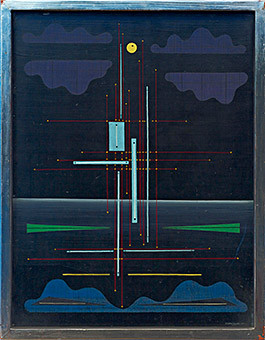Walter Grab
05 Jun - 15 Sep 2013
WALTER GRAB
Du peu de réalité
5 June - 15 September 2013
Mamco has taken an interest in the Swiss Surrealist petit-maître Walter Grab for various reasons. The ramifications of Surrealism have deeply penetrated the museum’s subconscious, as repeatedly displayed on the first floor of the building, for example in Gérald Minkoff’s Un portrait (‘A portrait’, winter 2010-2011) and above all in La vie dans les plis (‘Life in the folds’, summer 2012). As for Walter Grab, he is an unusual local example of the persistence of the Surrealist style and the flexibility of its themes.
Today, Walter Grab is practically unknown. This self- taught painter became part of Switzerland’s post-war art scene, and in 1950 he helped found the Phoenix group, which brought together Swiss, Austrian and German Surrealists such as Kurt Seligmann, Otto Tschumi, Ernst Fuchs and even Arnulf Rainer. During the 1950s, Grab took part in several exhibitions of international Surrealism, in Copenhagen, Munich, Berlin and Zurich. His works were included in Swiss museum collections in Zurich and Aarau, and in 1965, together with Meret Oppenheim, he even represented Switzerland at the São Paulo Biennial. But there—after, despite regular exhibitions at his gallery in Zurich, he lapsed into an oblivion from which Mamco is proud to rescue him—for although he remained on the sidelines of developments in the contemporary art of his time, Grab was a fascinating artist who over the decades evolved an ever more personal and controlled style until he eventually became a veritable petit-maître. So it is only logi- cal that he should be the next artist after Julius Kaesdorf to be exhibited in the Stanza.
His paintings incorporate various features from the Surrealist pictorial vocabulary. The most obvious of these are the pallid backgrounds, from glaucous blue or turquoise to pale yellow. Mixed in with this are biomorphic forms, figures reminiscent of Picabia, as well as a geometricism inherited from Kandinsky and texts, mathematical formulae and diagrams that recall scientific, even esoteric illustrations. The resulting images veer between Surrealistic landscapes and Modernist abstraction, coldly dreamlike images and science fiction. And yet, despite the growing idiosyncrasy of his work, Grab remained in dialogue with the Surrealists right up to the end of his life—as witness his Waldsymphonie (‘Forest symphony’, 1985) with its commentary on Max Ernst’s Forest (1927) and Forest and sun (1931), organised with the precision of an electronic circuit board.
Walter Grab was born in Affoltern (on the outskirts of Zurich) in 1927, and died in Zurich in 1989.
Du peu de réalité
5 June - 15 September 2013
Mamco has taken an interest in the Swiss Surrealist petit-maître Walter Grab for various reasons. The ramifications of Surrealism have deeply penetrated the museum’s subconscious, as repeatedly displayed on the first floor of the building, for example in Gérald Minkoff’s Un portrait (‘A portrait’, winter 2010-2011) and above all in La vie dans les plis (‘Life in the folds’, summer 2012). As for Walter Grab, he is an unusual local example of the persistence of the Surrealist style and the flexibility of its themes.
Today, Walter Grab is practically unknown. This self- taught painter became part of Switzerland’s post-war art scene, and in 1950 he helped found the Phoenix group, which brought together Swiss, Austrian and German Surrealists such as Kurt Seligmann, Otto Tschumi, Ernst Fuchs and even Arnulf Rainer. During the 1950s, Grab took part in several exhibitions of international Surrealism, in Copenhagen, Munich, Berlin and Zurich. His works were included in Swiss museum collections in Zurich and Aarau, and in 1965, together with Meret Oppenheim, he even represented Switzerland at the São Paulo Biennial. But there—after, despite regular exhibitions at his gallery in Zurich, he lapsed into an oblivion from which Mamco is proud to rescue him—for although he remained on the sidelines of developments in the contemporary art of his time, Grab was a fascinating artist who over the decades evolved an ever more personal and controlled style until he eventually became a veritable petit-maître. So it is only logi- cal that he should be the next artist after Julius Kaesdorf to be exhibited in the Stanza.
His paintings incorporate various features from the Surrealist pictorial vocabulary. The most obvious of these are the pallid backgrounds, from glaucous blue or turquoise to pale yellow. Mixed in with this are biomorphic forms, figures reminiscent of Picabia, as well as a geometricism inherited from Kandinsky and texts, mathematical formulae and diagrams that recall scientific, even esoteric illustrations. The resulting images veer between Surrealistic landscapes and Modernist abstraction, coldly dreamlike images and science fiction. And yet, despite the growing idiosyncrasy of his work, Grab remained in dialogue with the Surrealists right up to the end of his life—as witness his Waldsymphonie (‘Forest symphony’, 1985) with its commentary on Max Ernst’s Forest (1927) and Forest and sun (1931), organised with the precision of an electronic circuit board.
Walter Grab was born in Affoltern (on the outskirts of Zurich) in 1927, and died in Zurich in 1989.

